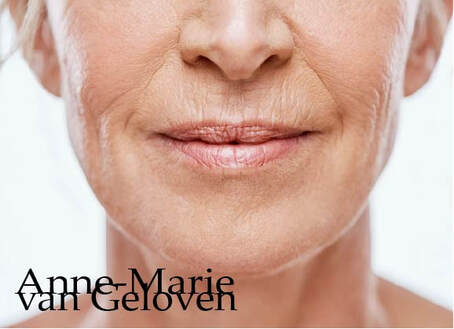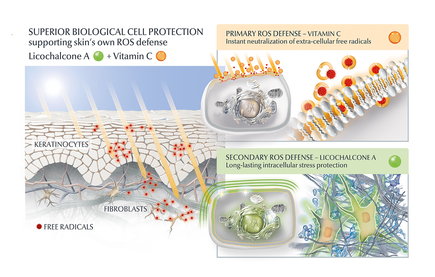
In skin biology, senescence is a process by which a cell ages and permanently stops dividing but does not die. This is why they are also referred to as "zombie cells". Age-related accumulation of senescent cells is caused by of increased levels of senescence-inducing stressors and/or reduced elimination of senescent cells. Under normal physiological conditions, senescent cells play an important role maintaining cellular homeostasis and inhibiting proliferation of abnormal cells. However, over time, large numbers of zombie cells can build up in the skin and contribute to the overall reduction in skin's regenerative properties, impacting both its beauty and health.
There are 2 forms of cell senescence: Acute senescence: Senescent cells are produced in response to acute stressors to facilitate for example tissue repair, wound healing. They are cleared by our immune system. Chronic senescence: A not programmed process as response to prolonged stress or damage and these senescent cells are not cleared by our immune system, leading to the accumulation of zombie cells impacting our skin health and beauty. It has been suggested that inflammageing is mainly related to senescent cells and their associated SASP (Senescence-Associated Secretory Phenotype) which increase in the body with age and contribute to inflammageing. Senescent cells cause inflammageing and inflammageing causes cell senescence. [1] Senescence can be triggered by a number of stress signals to the cell [1]:
Mechanisms of skin cell senescence:
The presence of senescent cells accelerates the ageing process due to their communication with nearby cells through various molecules: [18]
Fibroblast senescence could be the main driver of the skin ageing. [3] The increased number of senescent fibroblasts results in the production of SASPs rich in pro-inflammatory cytokines, including interleukin (IL)-1, IL-6, IL-8, IL-18, matrix metalloproteinases (MMPs), and a variety of other inflammatory chemokines [2] resulting in the breakdown of collagen, loss of elasticity and wrinkle formation. [3] Autophagy in dermal fibroblasts is essential for maintaining skin balance and managing the ageing process, particularly in response to external stressors like UV radiation and particulate matter (PM), by repairing cellular machineries. [4] Insufficient autophagy leads to an exaggerated skin inflammation triggered by inflammasome activation, resulting in accelerated ageing characteristics. When exposed to UVB (in vitro), skin cell types like fibroblasts and keratinocytes show DNA damage and increased senescence markers, such as increased SASPs. [3] Dermal fibroblasts also release insulin-like growth factor (IGF)-1, essential for epidermal cell proliferation and differentiation. [5] IGF-1 signalling in senescent fibroblasts is significantly decreased [6]. Inhibition of the IGF-1 pathway decreases collagen production in the dermis, causing epidermal thinning. Additionally, mitochondrial dysfunction and increased levels of superoxide anions prompt fibroblast ageing, thereby speeding up the skin ageing process. [5] Fibroblasts isolated from photo-aged skin produce a greater amount of pro-melanogenic growth factors. [14] Ageing-associated pigmentation has also been reported to be driven by (UVA-induced) fibroblast senescence. [15-16] Keratinocyte senescence The epidermis shows less impact of senescent keratinocytes due to their quicker turnover in comparison to fibroblasts. Senescent keratinocytes experience reduced ECM production and cell adhesions [8], along with elevated MMP expression in UV-induced senescence [9], and increased SASP levels, including pro-inflammatory cytokines. [10] Airborn particulate matter (PM2.5) can penetrate a disrupted skin barrier. PM2.5-induced ROS leads to epigenetic modification: reduced DNA methyltransferase, elevated DNA demethylase expression, p16INK4a promotor hypomethylation and therewith accelerated keratinocyte senescence. [11] Keratinocytes are the main type of cells that signal the need for melanogenesis. [12] UVR-induced DNA damage in keratinocytes activates melanogenesis. [13] Melanocyte senescence Senescent melanocytes express markers of inflammageing and dysfunctional telomeres. Senescent melanocyte SASPs induce telomere dysfunction and limit the proliferation of the surrounding cells, hence, senescent melanocytes affect and impair basal keratinocyte proliferation and contribute to epidermal atrophy. [17] STRATEGIES TO COMBAT CELL SENESCENCE PREVENTION Sunscreen: Protection against UV radiation combined with blue light defense (Licochalcone A: powerful anti-oxidant, Nrf2-Activator & increasing Glutathione + Colour pigments) and prevention + repair DNA damage (Glycyrrhetinic Acid) INTERVENTION Senotherapeutics can be classified into three development strategies: [25]
Skin care ingredients: [18]
Of course a healthy life-style and diet (consider also intermittent fasting) will support both your body & skin longevity and beauty Prevention and intervention of skin cell senescence offers a promising approach to improve skin health and beauty. Always consult a qualified healthcare professional or dermatologist to determine the most suitable approach for your particular skin condition and rejuvenation goals. Take care! Anne-Marie References
Comments

Reading the instructions on cleansing and care products can be misleading. When do I pat my skin dry first or when do I apply the product on damp skin? Even many recommendations from skin care guru's or skinfluencers are not completely correct.
In general it is recommended to apply a serum, eye care or moisturising / hydrating care product on damp skin, or immediately after bathing for the following reasons: Increased Absorption The primary benefit of applying skin care products to damp skin is that the skin is more receptive to the ingredients. Water helps to increase the hydration levels of the skin cells, which then improves the absorption of the skincare products. When the skin is damp, the skin's surface is more permeable, allowing the ingredients in the skin care products to penetrate deeper into the skin, and work their magic. Absorbing the ingredients more effectively, this leads to better results. The exception are products which require a very low pH level to penetrate, and be more effective, for example L-Ascorbic Acid (Vitamin C) and chemical exfoliating "acids" like hydroxy acids. The reason is that water has a pH level of 7-8, acidic formulations will be "neutralised" on damp skin. Better hydration Applying skin care products to damp skin helps to lock in moisture, leaving your skin feeling soft, supple, and hydrated. Hydration is critical for the skin because it helps to maintain and restore the skin's barrier function. The skin barrier protects the skin from losing hydration and prevents irritants and bacteria from entering. Applying serums and moisturisers on damp skin, increases the hydration benefits from the products. Improved spreadability Another advantage of applying skincare on damp skin is that it helps to improve the spreadability of the product. When we apply products such as serum or moisturiser to dry skin, they tend to settle in one area and can be challenging to spread evenly. On the other hand, when applied to damp skin, the skin care products can spread easily and evenly across the skin surface, ensuring maximum coverage and benefit. The exception are lipid rich products which are hydrophobe (water repelling), for example ointments, they might not spread evenly or easy on damp skin. Enhanced performance Applying skin care products to damp skin has been shown to improve their performance. This is because when products are applied to damp skin, they are less likely to evaporate, and the ingredients remain active for longer. This increased contact time with the skin leads to better, more effective results. The exception are products containing vitamin A, retinoids, tretinoin, retinal, retinol, retinaldehyde as damp skin increases the risk of irritation. Sensitive and hyper-sensitive skin Usually people with sensitive and hyper-sensitive skin have an impaired skin barrier function, hence ingredients will penetrate better in comparison to a resilient and well-functioning skin barrier. Applying products on (hyper)sensitive skin will therefore increase the risk of irritations. Be mindful which ingredients you use and use a pH rebalancing toner after cleansing and prior to any serum or care product you use. A toner is anyway an affordable product, which I highly recommend to use in every skin care routine. Read more. Study results on patients with dry skin and healthy volunteers In healthy subjects, compared to at control sites, the Stratum Corneum Water Content (SCW) was significantly higher at sites treated with the moisturizer immediately after bathing, with 1.0 and 2.0 mg/cm2 of the moisturizer, and with once- and twice-daily applications. In patients with dry skin, the SCW was significantly higher compared to control sites after 8 weeks when the moisturizer was applied twice daily. Read more. Take care. 
Glycation is one of the basic root causes of endogeneous (intrinsic) skin ageing and a very challenging one or almost impossible one to reverse. Glycation is an ageing reaction which begins in early life, developing clinical symptoms at around 30, and progressively accumulates in tissues and skin due to the glycated collagens that are difficult to be decomposed. Glycation occurs naturally in the body when sugars react with proteins and lipids to form advanced glycation end products (AGEs). AGEs can be exogenously ingested (through food consumption), inhaled via tobacco or endogenously produced and formed both intracellularly and extracellularly. AGE modifications lead to dermal stiffening, diminished contractile capacity of dermal fibroblasts, lack of elasticity in the connective tissues, contribute to hyperpigmentation and a yellowish skin appearance. The formation of AGEs is amplified through exogenous factors, e.g., ultraviolet radiation.
AGEs cause changes in the skin through 3 processes:
One study published in the Journal of Investigative Dermatology found that levels of AGEs were higher in the skin of older individuals compared to younger ones. The study also showed that there was a correlation between the level of AGEs and the severity of skin ageing. This suggests that inhibiting the production or accumulation of AGEs in the skin is a potential target for anti-ageing interventions or skin ageing management. AGEs are complex and heterogeneous, more than a dozen AGEs have been detected (however not all) in tissues and can be divided into three categories according to their biochemical properties. AGEs are formed through four pathways:
GLYCATION INHIBITION IS KEY AGEs can be crosslinked through side chains to form a substance of very high molecular weight, which is not easily degraded. The consequences from skin glycation are irreversible. This makes prevention or inhibition of the process the best potential strategy to maintain skin health and ageing skin management. One way to do this is by altering the diet to reduce the intake of sugars and carbohydrates, which are known to contribute to glycation. Several studies have found that reducing sugar intake can result in significant improvements in skin health, including reducing wrinkles and improving skin texture. 
AGE inhibitors
Another potential strategy is the use of topical agents that inhibit the formation or accumulation of AGEs in the skin. One study published in the Journal of Cosmetic Science found that a cream containing carnosine, a peptide that inhibits glycation, improved skin elasticity and reduced the appearance of wrinkles in individuals with ageing skin. Skincare containing NAHP or Acetyl Hydroxyproline inhibits the formation of AGEs significantly (in vitro), most likely through a mechanism where NAHP competes with the proteins for the sugar. Finally, NAHP sacrifices itself in place of the proteins and gets (at least partially) glycated. NAHP also prevents loss of cellular contractile forces in a glycated in vitro dermis model and counteracts the diminished cell-matrix interaction that is caused by glyoxal-induced AGE formation. Anti-Oxidants Moreover, I would suggest to combine those ingredients with an ingredient like Licochalcone A. Numerous high ranked publications support that Licochalcone A protects cells from oxidative stress mediated by e.g. UV and HEVIS (blue light) induced reactive oxidative species (ROS). Due to the activation and nuclear translocation of the transcription factor NrF2, the expression of anti-inflammatory, antioxidant and detoxifying enzymes are induced. These enzymes protect the skin cells (like keratinocytes and fibroblasts) from ROS-induced damage, like lipid peroxidation and DNA as well as protein damage. If Licochalcone A is combined with L-Ascorbic Acid, (the most active form of Vitamin C), it supporting skin's own collagen production, provides superior biological cell protection amongst other relevant benefits. My absolute favourite product is Eucerin Hyaluron-Filler Vitamin C Booster which I use daily as a serum in my morning routine. GLYCATION AND SKIN HEALTH Acne In addition to its role in ageing, glycation in the skin has also been linked to a range of skin health problems. One study published in the Journal of Cosmetic Dermatology found that the level of AGEs in the skin was significantly higher in individuals with acne than in those without acne. The study also showed that treating acne with a topical antibiotic significantly reduced the levels of AGEs in the skin. Atopic Dermatitis Another study published in the Journal of Investigative Dermatology found that individuals with atopic dermatitis had higher levels of AGEs in their skin than healthy individuals. This suggests that glycation may play a role in the development of inflammatory skin conditions. Diabetes + Woundhealing The correlation between high sugar levels and skin ageing can be seen in diabetic patients, where one-third of this population has skin complications. A prominent feature of ageing human skin is the fragmentation of collagen fibers, which severely damages the structural integrity and mechanical properties of the skin. Elevated levels of MMP-1 and MMP-2 and higher crosslinked collagen in the dermis of diabetic skin lead to the accumulation of fragmented and crosslinked collagen, thereby impairing the structural integrity and mechanical properties of dermal collagen in diabetes. Collagen crosslinking makes it impossible for them to easily repair, resulting in reduced skin elasticity and wrinkles. Keratinocytes and fibroblasts are the main cells involved in wound healing, but due to the high glucose (HG) microenvironment in diabetics, the functional state of these cells is impaired, thereby accelerating cellular senescence (programmed cell death). Conclusion We can't completely stop the glycation process, therefore it's important that we inhibit it from a young age onwards, hence monitor the sugar intake of our children, use daily SPF and invest in good dermo-cosmetic products containing ingredients like NAHP and powerful anti-oxidants like L-Ascorbid Acid (Vitamin C is needed for the production of collagen) and Licochalcone A (also anti-inflammatory). Preventing signs of ageing, specifically caused by glycation is most effective. If your skin shows (advanced) signs of ageing, you can get visible improvement using skin component (hyaluron, collagen and elastin) bio-stimulating ingredients like Retinol, Bakuchiol, Arctiin, Creatine or Glycine Saponin. Consult your dermatologist if you wish to improve your skin's appearance or skin health issues. Take care Special thanks: Ph.D. dr Julia M. Weise Manager Biological Testing & Dorothea Schweiger Lab Manager Facial Skin Biology Beiersdorf HQ Hamburg 2/18/2023 Comments Skincare peri and post menopause
Our life expectance is increasing and the average age when menopause occurs didn't change much in the last decade. This is why more women will have to care for post menopause skin for a longer time. During and after menopause our skin will go through some changes and might even become problematic. In this blog post I will have a closer look into these changes.
Change During the start of menopause, also called peri-menopause, women will notice some changes to their skin. This is because estrogen levels start to decline (-35% between age 35-50) and as estrogen level decline, androgen level proportionately become more dominant. As a result, the majority of women experience drier skin. Or when the hormone levels are differently balanced they may get a more oily skin or develop acne tarda (adult acne), because the oil gland activity is increased. Another problem is that the skin's pH level will increase, which will impact skin health, barrier and microflora or microbiome. A higher pH value may result in problematic skin. Loss of biological activity Around this period the metabolic biological activity in the skin will decrease faster than in our 20s or 30s. The production of important components like hyaluronic acid (filling + hydration), collagen (strength + structure) and elastin (flexibility + stretch) by fibroblasts (a very important skin cell) isn't sufficient, while the speed of their degradation is inclining because the skin's natural resilience against damaging free radical activity is reduced and the activity of degradation enzymes, like hyaluronidase, collagenase and elastase is elevated. Therewith the presence of those important skin components is declining 30% in the first years. This leads to more advanced signs of ageing skin and an overall loss of skin quality: skin firmness, skin surface eveness, skin tone eveness and glow (Goldie, Clin Cosmet Invest Dermatol, 2021). Solution Skin ageing is a multifaceted continuous biological degenerative process, with an impact on overall skin quality, self perceived attractiveness, confidence and comfort (Quality of Life). The optimal solution should improve all 4 emergent perceptual categories or EPG's of skin quality (an important component of human attractiveness) as mentioned above. This can be achieved by supporting skin's own resilience against the inclined loss by degradation (reduce free radical and enzymatic activity) and increase skin's own biological activity, hence skin's own production of hyaluron, collagen and elastin with bio-active ingredients or bio-stimulators and inhibit human tyrosinase activity (reduce age spots). I will explain the 4 key actions below: 1. Bio-stimulators Some evidence based bio-actives we can find in skincare are:
2. Enzyme inhibitors Some ingredients in skincare which inhibit enzymatic degradation are:
3. Anti-oxidants Damaging free radical activity is increased in mature skin and ROS (Radical Oxidative Species) increase degradation of all components, enzymatic degradation and human tyrosinase activity, a powerful cocktail of anti-oxidants is a "must-have". The combination of fresh activated L-Ascorbic-Acid (primary defence with instant neutralisation of extra-cellular free radicals) and Licochalcone A (secondary defence with long-lasting intracellular stress protection is a valuable addition in any day or nighttime skincare regimen. Licochalcone A is moreover one of the most powerful anti-oxidants (if not the most powerful one) proven to reduce (deep) oxidative stress from High Energy Visible Light or HEVIS. As we know, free radicals from HEVIS damage the important skin-cell called the fibroblast and increase the risk of age spots. A product which development was initiated, supported and clinically tested by me is Eucerin's Hyaluron-Filler Vitamin C Booster. I highly recommend this product, especially after a collagen-stimulating in-office procedure. 4. Human tyrosinase inhibition A relatively new, effective and safe ingredient in skincare which was tested on inhibiting human tyrosinase is Thiamidol. Other ingredients in skincare were tested on mushrooms (Hornyak, Journal of Investigative Dermatology 2018 & Mann et al. 2018) and are not potent in reducing human tyrosinase activity. It took 10 years of pioneering research (dr Ludger Kolbe) and comparing 50.000 actives to patent and market it. In the mean time Thiamidol is loved and recommended globally by many dermatologists and evidence based with 35+ studies including >2000 participants with all Fitzpatrick phototypes. Every AM routine should at least have a skincare product with SPF of 15 or higher. An improvement of skin quality leads to an improvement of quality of life (van Geloven et al. EADV 2022). Hope this was helpful. Take care 
Vitamin C is a "must have" skin care ingredient our skin needs at any age.
One of the best researched skin care ingredients and proven to be very beneficial for skin is Vitamin C. Our skin uses Vitamin C as an anti-oxidant and the dermal fibroblasts need Vitamin C for the production of collagen. Two very good reasons to add this ingredients into your daily skincare routine whether you are twenty or eighty. Moreover, our skin depends on us for the needed supply, as our skin is not able to produce Vitamin C itself. We can either include enough Vitamin C in our diet or apply Vitamin C topically there where we need it the most. Usually this is the skin which is exposed to (sunlight) as this increases damaging free radical activity in our skin. An active form of vitamin C can reduce the free radical activity, which we call anti-oxidative effect. There are 4 things to consider when buying a skincare product containing Vitamin C:
Day or night? Some recommend to use Vitamin C during the night, as the active form of Vitamin C will oxidize in daylight. Hence, your skin can benefit from the Vitamin C longer during the night. I would recommend Vitamin C to be used during daytime (thus added to your morning routine), as we need protection from damaging free radicals the most during daytime and the oxidization of Vitamin C is actually a sign that the ingredient is doing it’s job! It’s even better to add Vitamin C both to your day & night time skincare routine. Is L-Ascorbid Acid enough? Vitamin C is counteracting free radicals from UV light. However, UV is not the only damaging light form as there is also High Energy Visible Light or abbreviated HEVIS. This penetrates even deeper into the skin where also the dermal fibroblasts reside. The dermal fibroblasts are our collagen and hyaluronic acid producing cells and a key target in an effective anti-ageing skincare strategy. Lichochalcone A (Licorice-root extract) has proven to be the most potent anti-oxidant to protect the dermal fibroblasts and neutralize free radicals from HEVIS. Moreover, Lichocalcone A increases Glutathione, which is a skin’s own anti-oxidant. Licorice-root extract is an anti-ageing hero. Summary The combination of Vitamin C and Lichocalcone A will protect our skin and dermal fibroblasts from free radical damage by UV and HEVIS and will provide superior biological cell protection in comparison to Vitamin C only. For me this is a good reason to use a product containing both ingredients as a first step after my cleansing routine in the morning. If you have sensitive eyes, I recommend to use an eye care prior, which will form a barrier to help to prevent the low pH Vitamin C product to migrate into the eye area. Afterwards you can use the other products of your skincare routine. I would like to put emphasis on using a SPF of 30 or higher during the day. This will not only help to protect your skin, but also support the anti-oxidative benefits and make them last longer. Hope this was helpful. Take care! |
CategoriesAll Acne Ageing Aquatic Wrinkles Armpits Biostimulators Blue Light & HEVIS Cleansing CoQ10 Cosmetic Intolerance Syndrome Deodorant Dermaplaning Diabetes Dry Skin Evidence Based Skin Care Exfoliation Exosomes Eyes Face Or Feet? Facial Oils Fibroblast Fingertip Units Gendered Ageism Glycation Gua Sha Hair Removal Healthy Skin Heat Shock Proteins Hormesis Humidity Hyaluron Hyaluronidase Hypo-allergenic Indulging Jade Roller Licochalcone A Luxury Skin Care Lymphatic Vessel Ageing Malar Oedema Menopause Mitochondrial Dysfunction Mood Boosting Skin Care Neurocosmetics Ox Inflammageing PH Balance Skin Photo Biomodulation Polynucleotides Psoriasis Regenerative Treatments Review Safety Scarring Sensitive Skin Skin Care Regimen Skin Flooding Skin Hydration Skin Senescence Skip-Care Sleep Slugging Sunscreen Tanning Under Eye Bags Vitamin C Well Ageing Skin Care Wound Healing Wrinkles
Archives
April 2024
|



 RSS Feed
RSS Feed
